Focusing a telescope may sound intimidating, but it’s actually a remarkably easy process. In this article, we will explain what how to focus a telescope actually means, how focusers work, and why it’s important.
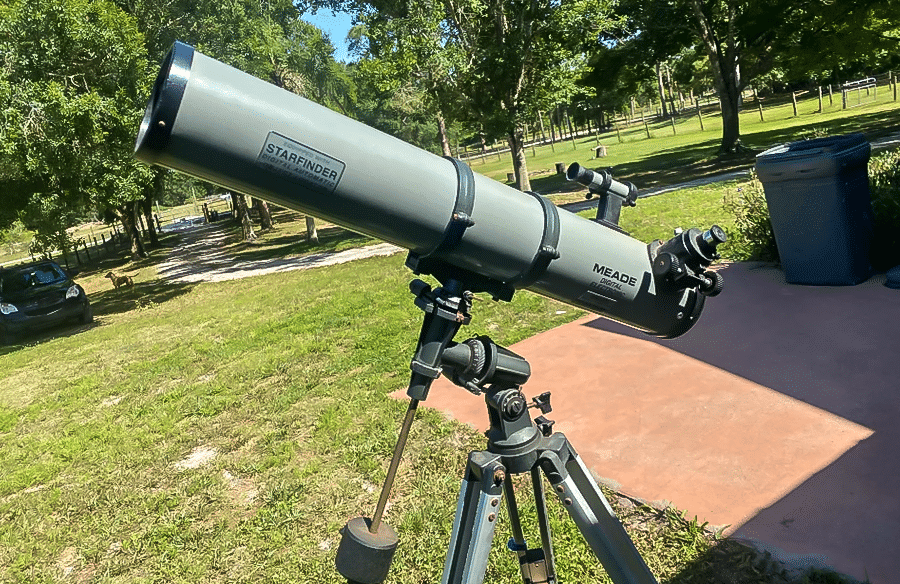
Most telescopes have an external focusing device that physically shifts the eyepiece or camera back and forth along the optical axis of the telescope (the path the light travels). The focal plane of the telescope has to either hit the sensor of a camera directly or land somewhere in the eyepiece where the final image is magnified for your eye to view.
Some telescopes, mainly Schmidt-Cassegrains and Maksutov-Cassegrains, focus by adjusting the primary mirror along a rod and thus shifting the spacing between the primary and secondary mirrors. This keeps the eyepiece/camera and other accessories at a fixed point attached to the back of the telescope. However, it can be a bit confusing for beginners as there’s no physical feedback when you adjust focus. Additionally, the mirror can shift or flop as it moves on the rod which can make the image appear to wobble when focusing at high magnification.
Contents
Types of Focusers
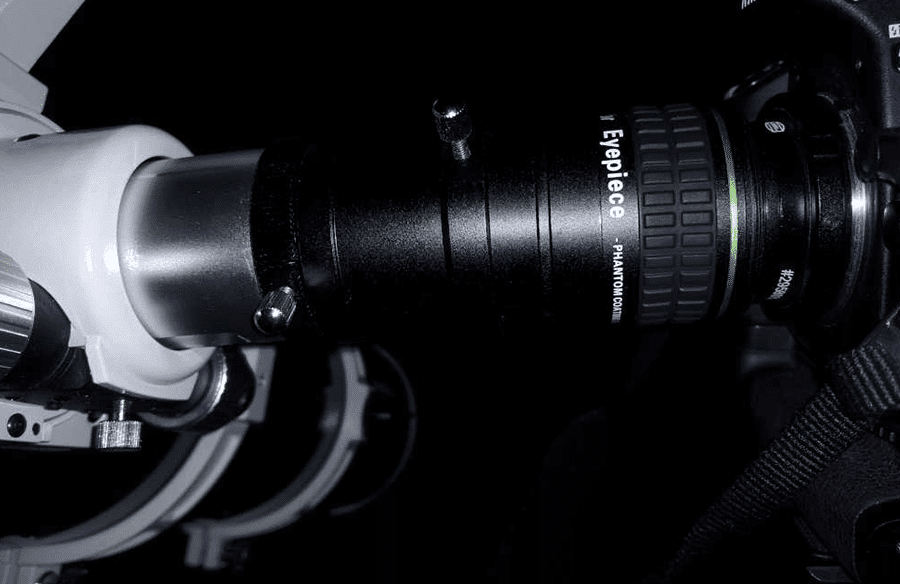
There are essentially four types of focusers commonly seen on amateur telescopes:
Helical focusers
Helical focusers use a threaded draw tube that spins back and forth or a smooth draw tube sliding on tilted rollers (in what’s known as a helical Crayford). They are very cheap, lightweight, can move very fast, and are easy to focus finely. However, threaded helicals can have a lot of play and wobble in them, and of course, rotating everything can cause problems with cameras, binoviewers, or certain accessories like astigmatism correctors or winged eyecups.
Rack-and-pinion focusers
Rack-and-pinion focusers move a set of teeth along a track, and are probably the single most common focuser seen on telescopes by far. Well-made rack-and-pinions are very stiff, often use rollers to support the drawtube, and are great for imaging purposes. Cheap rack-and-pinions with plastic teeth wobble, and the teeth can be easily damaged, which ruins the focuser entirely. Rack-and-pinion focusers are also hard to focus finely enough for use with high magnifications or fast focal ratio telescopes where precise focus is more critical.
Crayford focusers
Crayford focusers look much like a rack-and-pinion focuser but replace the teeth with a machined flat surface and rollers, often with Teflon in the mix – coincidentally, they were invented around the same time as the Dobsonian telescope, which relies on similar materials and friction-based mechanics. Crayford focusers have infinitely fine adjustment on account of their lack of any teeth or threads, and many have dual-speed knobs which allow for even finer focusing. Their only drawback is that they can slip when carrying very heavy loads, but this is only a problem for very high-end astrophotography setups.
Schmidt-Cassegrains & Maksutov-Cassegrains Focusers
As mentioned previously, many Schmidt-Cassegrains and Maksutov-Cassegrains use a very simple focusing mechanism where the primary mirror slides back and forth on a threaded rod. This has the advantage of no exposed moving parts, the ability to carry unlimited loads on the back, and keeping the optical system mostly sealed. Still, the mirror can slip, flop, and wobble during focusing which can become annoying. It’s also completely lacking in any kind of visible physical representation of where the focuser is positioned along its travel.
Most cheap telescopes are supplied with plastic rack-and-pinion focusers; Dobsonians and higher-end refractors tend to have Crayfords, and most catadioptric scopes use moving mirrors. Any good focuser will fit 1.25” or 2” eyepieces; 0.965” focuser should be avoided and 3” focusers do exist but are uncommon. Catadioptric scopes with moving-mirror focusers have threads on the back to attach a variety of different adapters.
Back Focus
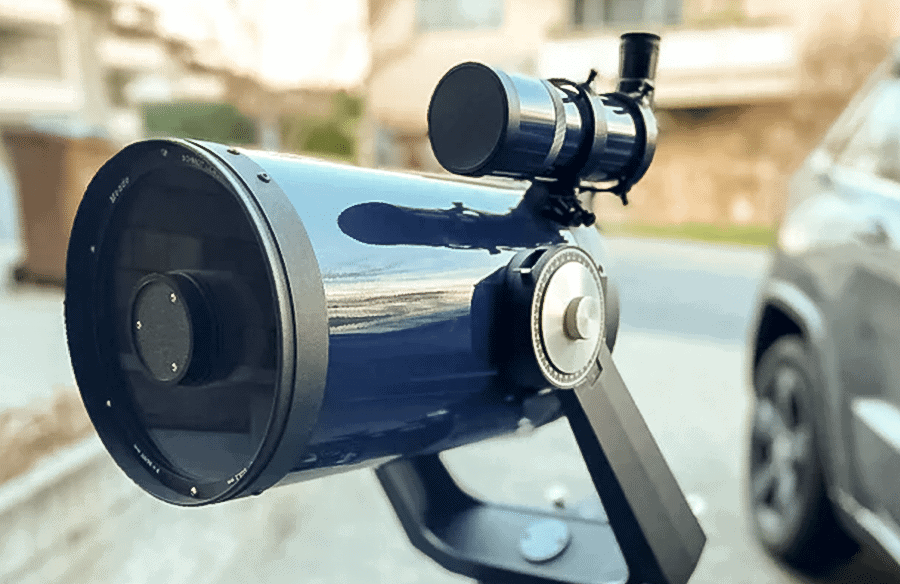
“Back focus” is the amount of inward travel from the normal focal plane that an item such as a camera, focal reducer, or binoviewer requires. Most eyepieces actually have the focal plane of a telescope placed somewhere inside of them, so with accessories that require “back focus” you need to be able to rack the focuser further inward than what is normally required for a typical eyepiece. This is why a lot of astrophotography telescopes tend to have extension tubes for use with regular eyepieces. Catadioptric scopes have nearly unlimited back focus; refractors tend to have plenty of back focus.
Newtonian reflectors can often lack back focus as they can’t have long focuser drawtubes without them interfering with the telescope’s optics. As a result, you can’t reach focus using a DSLR on many Newtonian reflectors and Dobsonians without cutting the tube, using a Barlow lens, or not extending the trusses fully if the telescope has a collapsible tube. However, if you are planning on doing astrophotography you should also purchase a telescope made for the job, such as an imaging Newtonian reflector which will have no problem reaching focus with any DSLR or astronomical-cooled camera.
How to actually visually focus an eyepiece
Focusing an eyepiece is a pretty simple affair – you turn the knob in whatever direction makes the image look more concentrated and sharp until there’s a sharp image and stars look like pinpoints. Generally, most eyepieces focus within about ¼” of each other which means turning the focus knob more than a few rotations is probably overdoing it. If your telescope has a 10:1 dual-speed fine adjustment knob, you can use that to dial in perfect focus at high magnification.
How to focus photographically
Focusing on a camera is a little more tricky. You need to use some sort of live viewing mode, and blow the image up as large as possible to be sure everything is correct. This may not be enough, however. A Bahtinov mask makes precise focusing of a camera much easier by dialing in until the precise spike pattern appears, and is cheap to buy or construct yourself out of paper, plastic, or cardboard.
Electronic auto focusers are also entering the market, which can take human error entirely out of the equation and refocus for different filters as well as compensate for tiny focus variations caused by temperature changes and mechanical flexing of the telescope over the course of a night.
Focusing a finder or guide scope
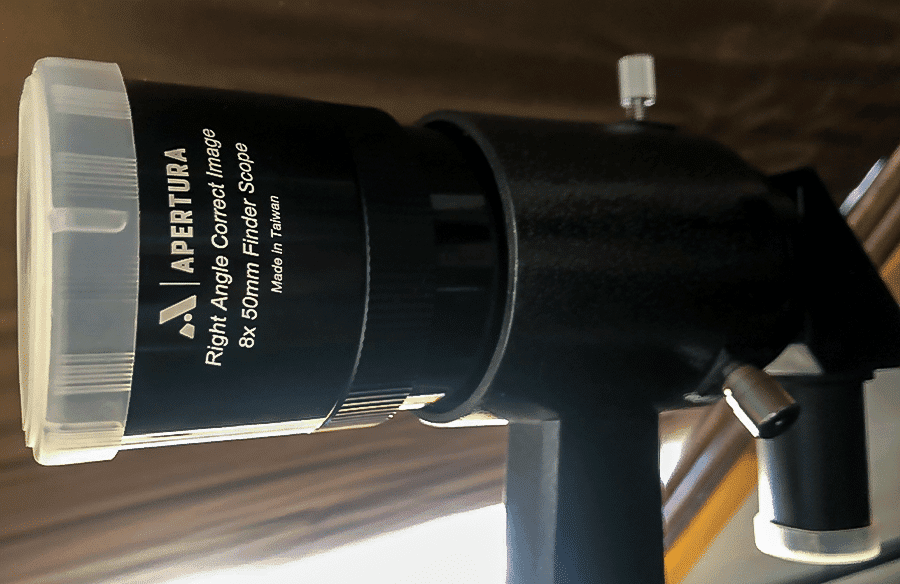
Many magnifying finders or guide scopes have some kind of focus system. There is usually a ring at the front which can be turned back and forth to move the objective lens forward or backward. Higher-quality finders/guides may have a helical threaded focuser at the back, or an eyepiece which has its own threaded focus system. You can often focus the crosshairs as well as the finder itself with these. Large finders or guide scopes may just have a regular Crayford or rack-and-pinion focuser attached to the back; older or low-quality finders and occasionally guide scopes may have a simple friction-fit system where you slide the eyepiece/diagonal back and forth to focus.
If possible, try to focus so that the crosshairs/reticle remain sharp to your eye along with the view itself. This may mean that you need to wear your eyeglasses to optimally see the crosshairs and target at the same time without one of the two appearing blurred.
Why can’t I reach focus? (visually) – A quick diagnostic guide
If you’re unable to reach focus with an eyepiece, there are a few steps you may be able to take:
- Are you using too high of a magnification? Magnification above 40-50x per inch is rarely advisable with any telescope on a good night; poor atmospheric conditions, bad optics, or bad collimation will limit you further. Same goes for viewing targets low on the horizon. If you can’t focus even at low power, you may have other problems.
- Is your telescope collimated? A mis-collimated instrument will have stars that appear to be always somewhat out of focus.
- If you’re using a 2” eyepiece, with some telescopes you may need an additional extension tube which is usually provided with the telescope.
- If you’re using a 1.25”/2” hybrid eyepiece, you may need an extension tube or to stick the eyepiece in your 1.25” adapter to add height to it.
- If you’re using a coma corrector, your telescope may not have enough back focus or your coma corrector may not be tuned to the right setting for a given eyepiece.
- If you’re using a binoviewer, you may need more back focus than is available. Most binoviewers come with an “optical corrector” (really just a Barlow lens) that will allow you to reach focus but you will be stuck at higher magnifications.
- If you’re using a Barlow lens, you may need an extension tube to rack the focuser out sufficiently far to reach focus.
- If you’re using a telescope designed for astrophotography, you probably need extension tubes.
- If you’re using a refractor or catadioptric scope, be sure that a star diagonal is in place.
- If you’re using a catadioptric, you may have racked the mirror extremely far away from where it needs to be to focus. You should be able to feel a hard stop at the limit in either direction of travel; the optimal point for focus with a typical eyepiece and diagonal tends to be near the middle of the mirror’s ability to travel along the threaded rod inside the telescope.
Why can’t I reach focus? (photographically) – A quick diagnostic guide
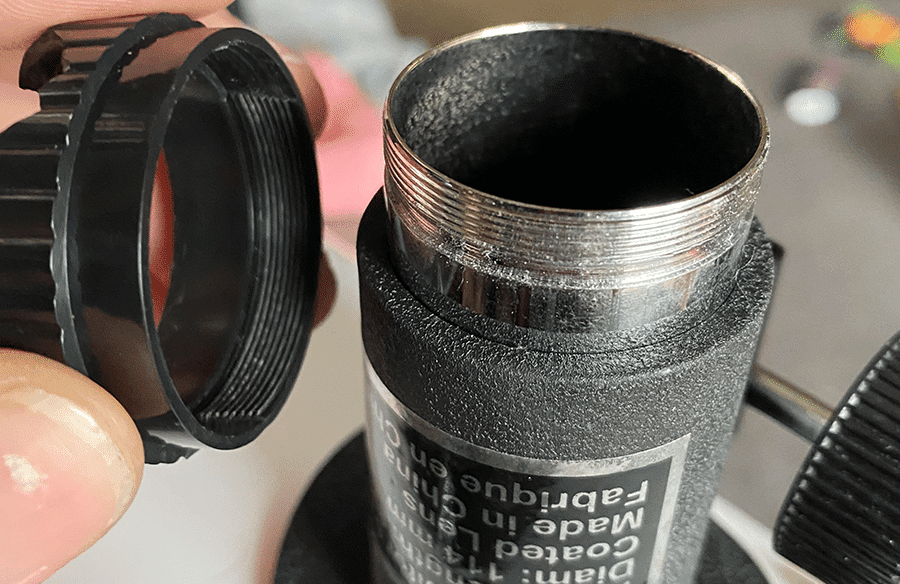
If you can’t focus your camera at all, the solutions are fairly obvious:
- If you are using a Dobsonian or Newtonian reflector without removable extension tubes or collapsible poles, your telescope is not designed for astrophotography and will not reach focus with a DSLR or cooled camera on its own. You can use a Barlow lens for planetary and lunar shots to reach focus, which is all a non-tracking instrument can be used for anyway.
- If you are using a Dobsonian/Newtonian with collapsible poles or removable extension tubes, try retracting the poles slightly, or removing all of the extension tubes.
- If you’re using a planetary imaging camera with Barlow lenses, you may have issues reaching focus if you stack multiple Barlows, either due to the shift of the focal plane or the fact that you’ve blown up the image too much. Try removing Barlows until the image is sharp and you can reach focus.
- If you’re using reducers, flatteners, or some coma correctors, you may need the correct spacing in order to reach focus. Consult manufacturers/vendors for the products you’re using or ask on forums like Cloudy Nights or Reddit – someone will be able to help you.
- If you’re using a commercial Classical Cassegrain or Ritchey-Chretien, you have to use some or all of the provided extension tubes to reach focus.
- If you’re using a refractor provided with extension tubes, such as those made by Explore Scientific, you generally at least need to use one or more extension tubes to reach focus. This may change if you are using a focal reducer or field flattener.
- As usual, make sure your telescope is collimated.
- With guide scopes and cameras, you may be able to get additional travel by loosening a sliding draw tube that supplements the main helical focuser attached to the back of the guide scope, or by removing the guide camera’s nosepiece and threading it directly to the focuser’s end, which tends to have the same threads as the camera body.

